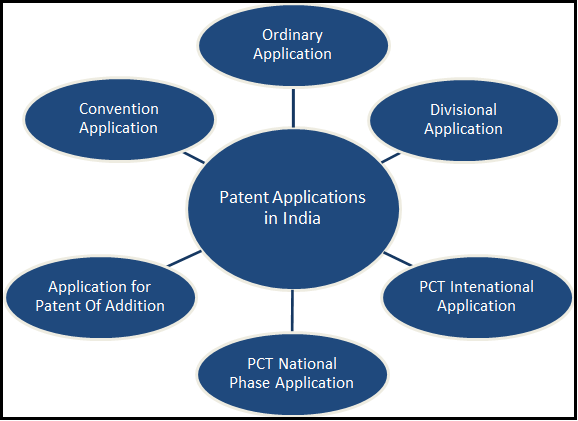A patent is a set of Intellectual Property rights granted to a patentee by the government to have an authority over the exclusive ownership and business prospects for an idea. It is granted for a specified period of time in lieu of detail information from the patentee regarding his/her invention or product. This right would deter others from making, selling, using, importing or processing the product(s) without the patentee’s consent. If any third party still manages to do any of the former stated acts, the patentee will have full power to take legal actions against that entity. It is, therefore, advised to know the finer details about the patent application types in India.
A patentee is benefitted from his/her invention due to the patent rights. He would not have to fear about any third party copying his ideas or making a profit from his invention directly/ indirectly as the Patent Law would forbid the entity to do so.
The patent system in India is governed by the Patents Act, 1970 (No.39 of 1970) as amended by the Patents (Amendment) Act, 2005 and the Patents Rules, 2003, as amended by the Patents (Amendment) Rules 2006 effective from 05-05-2006. According to this Act, there are six patent application types in India which are described below.
Also Read: Procedure for Patent Registrations in India
Ordinary Application
A patent application filed in the Patent Office that doesn’t claim any priority of application made in a convention country or without any reference to any other application under process in the office is called an ordinary application. An ordinary application should be submitted with a complete specification and claims.
Convention Application
According to Section 135 of Indian Patents Act, a convention application refers to the application filed by the applicant claiming priority date based on a similar application filed in one or more of the convention country. The applicant is required to file the application in the Indian Patent Office within 12 months from the date of filing of the basic application in another convention country. If applications are filed in two or more convention countries then the applicant has to file in India within 12 months from the date of filing of the earliest application.
As instructed by the Controller, the applicant would be required to furnish copies of specification or documents certified by the chief of the Patent Office of the convention country. A translated format of the above-mentioned documents must also be furnished if the language is anything other than English.
Similar Insight:
You don’t want to do these mistakes while filing your Patent Application!
7 Mistakes Start-ups make When Filing Patents
PCT International Application
The Patent Co-operation Treaty allows an applicant to seek protection internationally for their inventions and can be availed in 148 countries. One thing should be kept clear that the PCT application doesn’t provide the grant for an international patent. It allows the patent application to be submitted simultaneously in multiple countries within 30/31 months from the date of filing of PCT application. It is, therefore, the most cost-effective and comprehensive method for applicants aspiring to seek protection in multiple countries across the world.
An Indian applicant can file the PCT International application in three ways. They are as below:
- Filing an application in the Indian Patent Office (IPO) acting as the receiving office.
- Filing directly with the International Bureau of WIPO after getting foreign filing permit from IPO.
- The applicant can file in IB of WIPO after 6 weeks and within 12 months of the filing of an application in India.
PCT National Phase Application
A PCT International application can enter the national phase within 31 months from the priority date. The National Phase of a PCT patent application resembles a national filing in a respective country. This application is filed before the Controller of the Indian Patent Office and claims the priority and international filing date. The filing of PCT patent application is much simpler than that of filing of normal national application since most of the formal requirements are completed in the international phase itself. The applicant before entering the National Phase is required to furnish the following:
- Translated documents in English of- Description, Claims, Abstract, text matter of drawings
- A copy of International Application if the applicant has not received Form PCT/IB/308 and the Patent Office has not received a copy of the international application from the International Bureau under PCT Article 20.
Similar Insight:
Filing PCT patent application by an India Applicant
Is it necessary to hire a patent agent to file a patent in India?
Patent of Addition
When an applicant feels that his invention is a slight alteration of the invention for which he has already applied for or has obtained a patent, the applicant can go for a patent of addition. However, the invention must not involve a substantial inventive step. The applicant need not pay a separate renewal fee for the patent of addition during the term of the main patent. The patent of addition would expire along with the main patent until and unless it is made independent.
Similar Insight: What is the cost for Patent Registration in India?
Divisional Application
When an application made by the applicant claims more than one invention, then out of the applicant’s own request or as instructed by the Controller the applicant would be required to divide the application and file separate applications that would be applicable for each invention. This type of application that is divided from a primary one is referred to as Divisional Application. The priority date would, however, remain unchanged and same as that of the primary or parent application.
Also Read:
How to File Patent Application Globally?
What to know about filing Different Types of Patent Applications?
Here you can Download our FREE Help Guides:
- Procedure for Patent Registration in India (click here for download access)
- Patent Registration Fees in India (click here for download access)
Click Here to Get Download Access (All Free Resources)





